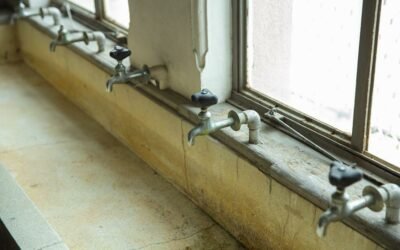Do you know what brick mold on a window is and why it's important?
In this article, we'll delve into the construction, function, and common problems associated with brick mold.
You'll gain a better understanding of this essential component of windows and learn how to properly maintain and repair it.
So, if you're ready to become an expert on brick mold, let's dive in and explore this crucial element of your windows.
Key Takeaways
- Brick mold is a protective barrier against moisture and prevents water damage to the window frame.
- It provides a weatherproof seal, redirects water away from the window, and improves energy efficiency.
- Common problems with brick mold include gaps, warping, water damage, drafts, and aesthetic issues.
- Maintenance and repair of brick mold involve regular inspections, cleaning, sealing, and occasional replacement or painting.
What Is Brick Mold
Brick mold is a strip of material that's typically installed around the perimeter of a window, serving as a protective barrier against moisture and providing a finished look. It's an essential component of window installation, as it helps to keep water from seeping into the window frame and causing damage. The brick mold is usually made of wood or PVC, and it's designed to withstand exposure to the elements.
When installing brick mold, it's important to ensure that it's properly aligned and securely fastened to the window frame. This can be done using screws or nails, depending on the material of the brick mold. The corners of the brick mold should be mitered and sealed to prevent water infiltration.
In addition to its functional benefits, brick mold also enhances the aesthetic appeal of the window. It gives a neat and finished appearance to the exterior of the window, adding a touch of elegance to the overall design of the building.
Construction of Brick Mold
To construct brick mold, you'll need to gather the necessary materials and tools. Firstly, you'll need a measuring tape to accurately measure the dimensions of the window opening. Next, you'll require a miter saw or a miter box with a handsaw to cut the brick mold material at precise angles. The brick mold itself can be made from various materials such as wood, PVC, or metal. Wood is the most commonly used material due to its durability and ease of customization.
Once you have the materials and tools ready, you can begin the construction process. Start by measuring and marking the dimensions of the brick mold on the material. Use the miter saw or miter box to cut the material at 45-degree angles for the corners. Ensure that the corners fit together tightly and make any necessary adjustments.
To attach the brick mold to the window frame, use galvanized nails or screws. Place them at regular intervals along the length of the brick mold, ensuring a secure and stable attachment. Finally, check that the brick mold is level and plumb before proceeding to seal any gaps between the brick mold and the window frame using caulk.
Function of Brick Mold
The function of brick mold on a window is to provide a protective barrier and weatherproof seal around the window frame. It serves as a crucial component in ensuring the longevity and durability of the window installation. By creating a barrier between the window frame and the surrounding brick or siding, brick mold prevents water infiltration, which can lead to rotting, mold growth, and structural damage.
The design of brick mold allows it to redirect water away from the window frame, preventing moisture from seeping into the building. It's typically installed with a slight slope, directing water downward and away from the window. This helps to protect the window and the surrounding wall from water damage, ensuring the structural integrity of the building.
Additionally, brick mold acts as a protective layer against wind, dust, and other outdoor elements. It helps to create a tight seal between the window and the wall, preventing drafts and energy loss. This helps to improve the energy efficiency of the building and reduces heating and cooling costs.
Common Problems With Brick Mold
One common problem with brick mold on a window is improper installation. This can lead to a variety of issues that compromise the functionality and aesthetics of the window. Here are five common problems that may arise due to improper installation:
- Gaps and spaces: If the brick mold isn't properly aligned and secured, it can result in gaps and spaces between the window frame and the brick mold. This allows for the infiltration of air, water, and pests.
- Warping: Improper installation can cause the brick mold to warp over time. This can lead to a distorted appearance and affect the overall performance of the window, such as difficulty in opening and closing.
- Water damage: When the brick mold isn't sealed correctly, water can penetrate into the window frame, causing rot, mold, and water damage. This can compromise the structural integrity of the window and result in costly repairs.
- Drafts and energy loss: Inadequate installation can create gaps and openings that allow drafts to enter the space, leading to energy loss and increased heating or cooling costs.
- Aesthetic issues: Improperly installed brick mold can detract from the overall appearance of the window and the building. Gaps, misalignment, and warping can make the window look unattractive and decrease curb appeal.
Maintenance and Repair of Brick Mold
To properly maintain and repair brick mold on a window, it is essential to regularly inspect and address any issues that may arise. By taking proactive steps, you can ensure the longevity and functionality of your brick mold. Here are some maintenance and repair tasks that you should consider:
| Task | Frequency | Description |
|---|---|---|
| Inspect for damage | Annually | Carefully examine the brick mold for any cracks, chips, or signs of decay. |
| Clean and remove dirt | Biannually | Use a mild detergent and water solution to clean the brick mold surface. |
| Seal gaps | As needed | Fill any gaps or holes with a high-quality silicone sealant. |
| Repair or replace | As necessary | If the brick mold is severely damaged, consider repairing or replacing it. |
| Paint or stain | Every few years | Apply a fresh coat of paint or stain to protect the brick mold from weathering. |
Remember to follow the manufacturer's instructions when performing any maintenance or repair tasks. Additionally, it is recommended to hire a professional if you are unsure about any aspect of the process. By properly maintaining and repairing your brick mold, you can enhance the aesthetic appeal and functionality of your windows.
Conclusion
To sum up, brick mold is a crucial component in window construction that serves multiple functions. Its primary purpose is to provide a smooth transition between the window frame and the surrounding brickwork, ensuring a secure and weather-resistant seal. However, brick mold can also experience common issues such as rot, damage, or improper installation.
Regular maintenance and prompt repairs are essential to extend its lifespan and maintain the overall integrity of the window structure.





0 Comments